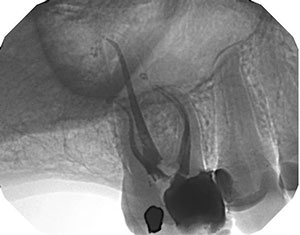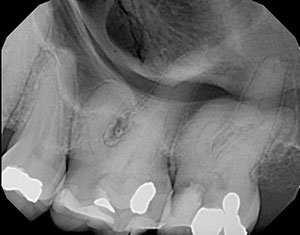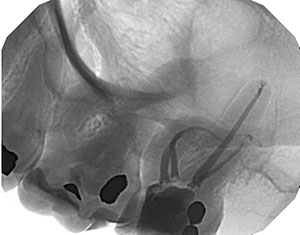
People ask me how I feel about the variable taper in endodontics. It’s an old concept that resurfaces that tries to prevent “taper lock.” The V-Taper2H by SS White is a variable taper file. Variable tapers minimize the engagement of the file against the canal wall. Think of one plastic cup placed in another (constant taper) versus a plastic cup stacked on a Styrofoam cup (variable taper).
For example, a patient came in with pain on tooth No. 3. The diagnosis was acute irreversible pulpitis. The mesial and distal roots were curved with a long palatal root up in the sinus. A file system that is very strong yet flexible is vital for a nice outcome. So, I decided to use the 2-mm V-Taper2H for this case (Figures 1 and 2).
 |
 |
|
Figure 2. The post-op x-ray shows curves in all 4 canals. The disto buccal root has an S-shape curve. The mesial buccal and second mesial buccal canals have separate exits. |
Figure 3. The pre-op x-ray shows a temporary restoration with recurrent decay into the pulp on tooth No. 15. The mesial buccal root has a very nasty distal turn. |
 |
|
Figure 4. The post-op x-ray shows the second mesial buccal joined with the mesial buccal. This happens 60% of the time. Notice the slight S-shape of the mesial root. |
When you use crown down as your method of cleaning and shaping with new file technology, the variable taper concept is a moot point. The metallurgy is now “softer” but stronger and, therefore, more flexible. Also, crown down allows your irrigation agent (I like full-strength sodium hypochlorite) to work more efficiently.
As a result of better manufacturing and technology, we now have the ability with constant taper files to create predictable, reproducible shapes around curves and calcified canals. Heat treated files such as the Edge Endo Edgefile X7 (second case on tooth No. 15) work similarly to the Vortex Blue from Dentsply Sirona Endodontics.
In another case, a patient came in with pain on tooth No. 15. The diagnosis was chronic irreversible pulpitis. The mesial root makes more than a 90° turn. Upon access, there was a second mesial buccal, which was about 40% of the upper maxillary second molar. I wanted to use a file system that was strong and very flexible, so I decided to use the 25mm X7 Edge File with constant .04 taper (Figures 3 and 4).
So I always tell dentists and other endodontists to understand what they are using and why they are using it. Are your results consistent? How does it work in your hands with your system and philosophy? If you do that, then the file type really doesn’t matter much.
Dr. Short attended the Medical College of Georgia (MCG) School of Dentistry to attain a DMD degree in 1999. In 2002, he earned his postdoctorate degree in endodontics from Nova Southeastern University and then became a Diplomate of the American Board of Endodontics in 2009. Dr. Short is an expert consultant in endodontics to the Georgia Board of Dentistry and assistant clinical professor at the Dental College of Georgia in Augusta. He is endorsed by the American Association of Endodontists speakers bureau, and his private practice, Apex Endodontics PC, is located in Smryna, Ga. Dr. Short also has authored a book, Getting to the Root of Your Problem: 365 Days of Inspirational Thinking. He can be reached at dr.short@yahoo.com.
Related Articles











